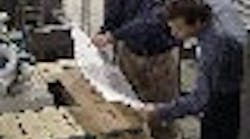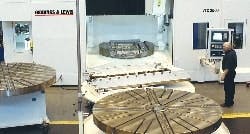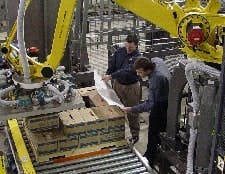Many machine builders are responding to these customer demands by merging or by joining closely knit industry groups. Affiliations can help machine builders cope with globalization, but joining a group also can present challenges.
Consolidation Worldwide
The North American machine builder industry is very fragmented with hundreds of firms that range from having a few million dollars to more than $1 billion in annual revenues.
By contrast, the European machine builder market is both bigger and more concentrated, especially in the packaging sector. "The packaging machine industry is so much bigger and concentrated in Europe that it's difficult to even compare it with North America," says David Humphrey, European senior analyst at market research firm ARC Advisory. "Continuing consolidation in the European packaging machine market is driven by two main factors. First, companies acquire others to gain technology or market share. Second, companies expand into new areas by designing new machines, thus consolidating more machine types under one brand name."
The situation in Asia is quite different. "Japan still is fragmented with many small packaging machine builders and a few majors," states Shube Abe, general manager of ARC Japan. Arcot Rajabahadur, ARC's director in India, reports the packaging machinery industry in India also is fragmented with many small manufacturers and few large ones.
ARC says both the Japanese and the Indian markets have yet to experience much in the way of consolidation. Some low-cost machines from China now are in the marketplace, but they have yet to make a significant impact.
Consolidators Are Active
The machine builder industry in North America and in Europe is rife with mergers and acquisitions. Other markets have been slower to move towards consolidation.
But is consolidation a good thing for you and your company? Or is it a serous threat to your livelihood?
Before we sort that out, we first need to describe the market in more detail. Consolidators believe they can make money by buying and combining machine builder operating companies. We'll define an operating company as an entity that makes money by making and selling machines. By contrast, a consolidator makes money by buying and adding value to operating companies.
Some of these consolidators started as machine builders, while others are strictly financial entities. Consolidators typically go public to raise money to buy machine builder operating companies.
One thing is certain: consolidators are prodigious consumers of revenues generated by their operating companies. Consolidators' executives typically carry fancy titles like CEO, CFO, and COO, with salaries to match. Consolidators' expenses can be quite significant even when head counts are small.
Many of these consolidators are publicly traded, so there also is the considerable expense of market listings, investor relations, and financial reporting. Throw in the requisite PR firm to promote the consolidator, and these overheads can become a considerable financial burden for the operating companies to bear.
As a result, consolidators work hard and smart to wring extra profits out of the operating companies to cover their own expenses, and even more profit must be generated to justify acquisition prices.
The theory is that the consolidator can create synergies among the acquired operating companies and make 1 + 1 equal something more than 2. The challenge is ensuring that the synergies are financially substantial and sustainable.
One disturbing finding was the reticence of boardroom-level consolidators to comment for this article. Evasiveness often is a bad sign, and it can fuel fear, uncertainty and doubt. We did get some good input from industry consolidator Pro Mach (see this article's sidebar for details).
Machine Builders Have Plenty to Say
While the message from the consolidators' boardrooms is ominous silence, machine builders have plenty to say about consolidation, much of it positive.
Battenfeld Gloucester Engineering makes plastics processing equipment for films including extruders, pullers, and winders (See Figure 1 below). Although independent, they see many advantages of consolidation.
Another independent company that sees the benefits of consolidation is Micro Component Technology (MCT). MCT makes strip-test handlers and strip-laser markers for the semiconductor industry. "We are comfortable going it alone, but especially in management, we think there would be significant benefits to being one division of a larger whole," observes Richard Sidell, Sc.D., vice president and CTO of MCT. "It might give us more financial stability. It probably would give us more credibility with customers. It might offer opportunities to share related technology with partners in other divisions." Sidell also thinks consolidation would offer clearer professional growth paths for MCT employees.
Meanwhile, Dynatorch, a builder of CNC plasma and oxy cutting machines, voices a dissenting opinion. It, too, is independent, not part of a larger industry group, and has no interest in being consolidated. "Being part of a group would harm our flexibility," says Leon Drake, Dynatorch's chief engineer. "We often make decisions on projects in less than a day. We also have low overhead, but if we were part of a larger group, we'd need to add overhead personnel to deal with the reports and paperwork for reporting to a parent organization. We enjoy our freedom."
Aid From Alliances
Triangle Package Machinery is a privately held and operated company that makes baggers, computer combination scales, cartoners, and automatic-depositing systems. It's a charter member of the Packaging Machinery Manufacturers Institute (PMMI) industry trade association. They recently formed a formal alliance, known as Chicago Area Manufacturers Assn. (CAMA) with three other Chicago-area packaging machinery companies.
Triangle reports membership in PMMI and CAMA gives it many of the advantages of consolidation, but without the drawbacks. "We now have the ability to provide an integrated machinery solution to a customer, instead of just our standalone machines," claims Sam Gall, Triangle's international sales director. "Plus, these organizations allow us to leverage our sales force when looking for sales opportunities. We also can network with our partners to improve purchasing and employee insurance."
Gall concedes that loosely grouping firms through industry organizations can present problems. "We might be perceived as not willing to work with other companies that provide similar machinery to those in CAMA," he says. "Also, it's harder to work together when a project is running into some difficulty, and to trust each other to work toward the betterment of the system."
"We were acquired only recently, so it is way too early to know what the effects will be at my level," reports Buchanan. "But, being part of a larger group should have several advantages. We can get group pricing on components, share resources and overhead, and pool energies on things like CE standards."
On the flip side, Buchanan thinks, as part of a larger group, corporate collaboration efforts can be more difficult due to the increased number of technical and management people involved. "Communication within a larger organization also can be more challenging," he suspects.
It's Your Move
What should you do if your company is acquired by a consolidator? First, try to find out if the consolidator intends to invest and improve, or if they simply want to cut costs by stripping assets and reducing headcounts. True investors know your industry, and should be willing and able to demonstrate this knowledge through face-to-face communications and other actions.
Asset strippers and cost cutters tend to be much more evasive, preferring to communicate with you via vague e-mails and press releases. Their focus tends to be on the investment community rather than on acquired operating companies. If an asset stripper acquires your operating company, prepare your résumé, and get it out there quickly before you are stripped of your livelihood.
If an investor-oriented company is the acquirer, take the advice of some of the machine builders we've reported on here. Try to take advantage of group membership by sharing best practices, offering more integrated solutions to customers, and using the power of the group to negotiate better pricing.
Growing Globalization
Consolidation is a growing fact of business, often driven by globalization. How is globalization of supply chains, customers, and competitors affecting you and your peers?
Battenfeld Gloucester Engineering makes most of its equipment in the U.S., but to reduce costs, it sources components and ancillary equipment through its sister company in China.
The firm sells worldwide, and is challenged to comply with metric and CE standards, among other issues. "Customer expectations differ," says Battenfeld's Brancaleone. "Overseas customers tend to view complete systems when purchasing our equipment. North American customers have a more componentized view, and buy machines to build their own systems."
The company's main competitors are German, and Battenfeld finds competing on a competitor's home turf can be very difficult. "My advice is to find a good niche market, and run with it by getting your foot in the door and proving yourself," adds Brancaleone. "Remember that providing quality service in a timely manner can be quite challenging."
Similarly, Alliance Machine Systems builds material handling equipment and specialty folder/gluers for the corrugated box industry. Its builds approximately 350 machines worldwide each year, 250 in the U.S., and 100 in Europe. It sells these machines primarily in North America and Europe, but also in the Middle East, Africa, and the Far East.
Alliance's main challenges are meeting safety requirements. "While European countries all accept machines labeled with the CE mark, there are local inspection agencies that interpret codes differently," reports Mike Harrington, director of R&D at Alliance.
The firm's primary competitors are European, but it's starting to see some Korean and Taiwanese machine builders enter the marketplace. "Price competition is intense overseas. U.S. customers are more interested in features and productivity, while in other markets purchasing decisions are made based more on price than productivity improvements," observes Harrington.
Andritz makes equipment for the pulp and paper industry, manufacturing in North America, Austria, and Finland. As with the machine builders above, Andritz is challenged to provide equipment that meets local standards.
Competition must be addressed in cost and perceived quality. "Some of our auxiliary equipment such as lube skids can sometimes be made cheaper by our competitors," says Mike McLaughlin, director of automation for pulp and paper service in North and South America. "When it's perceived that the overseas suppliers may have a better solution, I refer to it as the BMW versus Chevy concept."
The most important competitive factor, adds McLaughlin, is local support. "We strive to provide superior service so that our customers know that they can count on us when they need us," he adds.
Industry giant Goss International manufactures commercial presses, newspaper presses, bindery, and mailroom equipment in the U.S., and sells worldwide. Most of its competitors are outside the U.S. "Complying with geographic/local standards, supporting customers due to language barriers and time differences, and working through agents versus our own sales organization are problems that we face," observes Chris Cote, manager of R&D electrical engineering at Goss.
Most of the consolidators contacted for this article refused to speak with us. A notable exception was Pro Mach, provider of integrated packaging solutions for food, beverage, household goods, and pharmaceutical companies.
Pro Mach's divisions include Allpax, Axon Corp., Fowler Products, Ossid Corp., and Roberts PolyPro in primary packaging; Brenton Engineering, Orion Packaging, Wexxar Packaging, and Rennco in end-of-line packaging; and ID Technology in identification and tracking.
There are many advantages to consolidator ownership for machine builder operating companies, if you listen to Mark Anderson, Pro Mach's president and chief operating officer. "Customers want integrated solutions across part or all of their packaging lines, a single-vendor purchasing process, and the reduced risk that often comes with buying from a well-financed company," he argues. "Building high quality equipment often is not enough of a differentiator for a supplier."
Anderson believes his divisions have an opportunity to deliver more value to their customers, gain some business they likely never would have been able to get by themselves, and develop new products and integrated solutions along with the other divisions. They also have the financial support that comes from being part of an overall larger organization.
"Our customers want more modular standardized platforms for their packaging lines," continues Andersen. "We can provide integrated solution sets from machines built at our divisions with the assurance they will interoperate with the efficiency our customers expect. Because we have multiple divisions building machines across a range of the packaging line, we can provide integrated solutions without becoming a system integrator. And while modularization and standardization are young initiatives in packaging machinery, we support them and believe that operating multiple machine-building divisions gives us an advantage in this area."
Some of the more obvious advantages to having multiple divisions include a wider pool of expertise, sharing information and resources, and working together to develop more efficient processes across the organization. "In 2006, we're working to implement lean manufacturing practices company-wide," continues Andersen. "This is something that I have done at several manufacturing organizations before joining Pro Mach. We're just getting started now, but we believe it will help us build our products cheaper and better."
Pro Mach thinks that being part of an organization with multiple divisions or companies also provides some insulation against being marginalized into a tight niche.
Andersen acknowledges some potential disadvantages associated with consolidation including loss of brands, technology, and the entrepreneurial spirit. "To prevent this we purposely retained the names and brands of our divisions," he says. "More importantly, we've retained their expertise and we work to foster a spirit of innovation and idea sharing. We've organized our divisions into three business units: primary packaging, end-of-line packaging, and identification and tracking. Each of those business units is led by a president who once was president of an acquired division."
Andersen firmly believes his company collectively is much stronger than any one of the companies could be individually.
There's every reason to believe that North American machine builders will continue to adapt and succeed on a global basis. Consolidation through acquisitions and mergers may help machine builders compete globally, and looser affiliations such as industry groups will also aid global competitive efforts.
Advantages of Consolidation
- More financial resources
- More stable. One business unit can be up when another one is down
- Ability to share technology and best practices among operating companies
- Can offer customers a more comprehensive solution
- Parts and services from a sister company are lower cost than from another supplier
- Clearer professional growth paths for employees
- More credibility with customers
- Easier to service global customers if group members are globally disbursed
- Can leverage sales force
- Can negotiate better pricing with suppliers
Disadvantages of Consolidation
- More corporate overhead
- Less contact between management and operating companies
- Harder to make quick decisions
- Loss of brands
- Less entrepreneurial spirit
Main Competitive Global Challenges
- Competing with lower-priced competitors
- Providing local support
- Complying with local codes and standards
- Competing with local companies that have home field advantage
- Meeting varying customer expectations
- Complying with local safety requirements
- Paying for travel expenses
- Dealing with customer perceptions with respect to quality
- Dealing with language barriers
- Accounting for time differences
How One Machine Builder Copes With Globalization
Micro Component Technology (MCT) makes strip test handlers and strip laser markers for the semiconductor industry. "Our machines serve the back end of semiconductor manufacturing, after assembly and before singulation," says Richard Sidell, Sc.D., MCT's vice president and CTO. "We do the material handling of parts in final electrical test. Unlike traditional test handlers, we handle strips of parts after assembly and prior to singulation. Our machines are made in Minnesota and Malaysia, with most of the manufacturing in Malaysia."
MCT's handlers are installed in Thailand, Malaysia, Philippines, Singapore, China, Korea, Taiwan, and Europe. The companies it sells to all have headquarters or significant operations in the U.S. In the Philippines and Ireland, it sells to Analog Devices, a Massachusetts-based company. Major accounts in Thailand include National and Microchip, both headquartered in the U.S. In the Philippines, Taiwan, and Thailand, MCT sells to Philips, which is headquartered in the Netherlands. The company also sells to Amkor, a Korean company with operations in the U.S., Korea, and Philippines.
"Due to the globalization of these major companies, and the moderately high cost of the capital equipment we sell, most sales involve customer participation and decision making in many countries," says Sidell. "This breaks many of the old sales models, especially for distribution and representation. The salesman who closes the order might not be from the same organization as the one that will have to support the equipment. This creates issues in commission splitting, discounting, and support."
Because of these issues, Sidell says MCT uses its own global sales force almost exclusively, so it relies on travel, electronic communications, and cooperation between salespeople in different districts.
Regions just don't exist any more in this business," he adds. "We compete with machine builders based outside of North America, which is why we became an international machine builder."
MCT develops software in the U.S. and the Philippines, and centers its sales force in Singapore. "We have purchasing operations in both countries, since some commercial parts are more available or less expensive when purchased in the U.S.," says Sidell. "We send a consolidated shipment once a week from the U.S. to Malaysia."
Sidell states the main challenges in competing with overseas machine builders are their lower labor and machined parts costs. "We find the cost of machined parts in Southeast Asia is about one-third of the U.S. costs," he says. "Labor, including skilled labor such as engineering and manufacturing technicians, is about a fifth to a tenth the cost for corresponding work responsibility and quality in the U.S."









